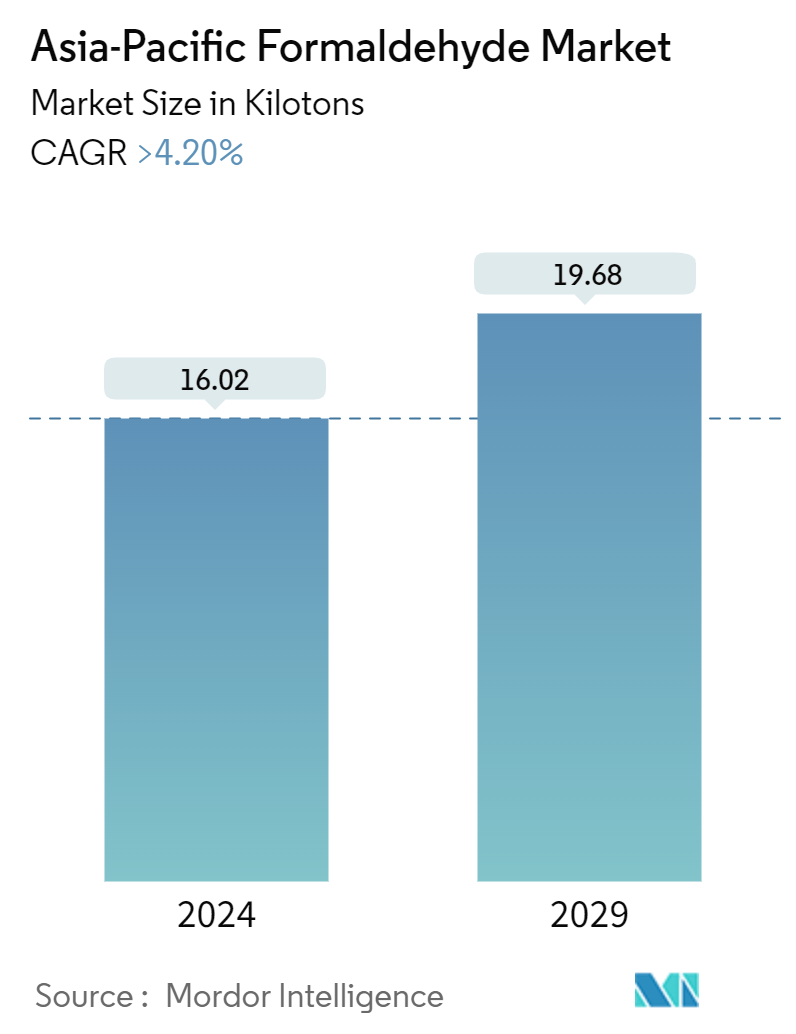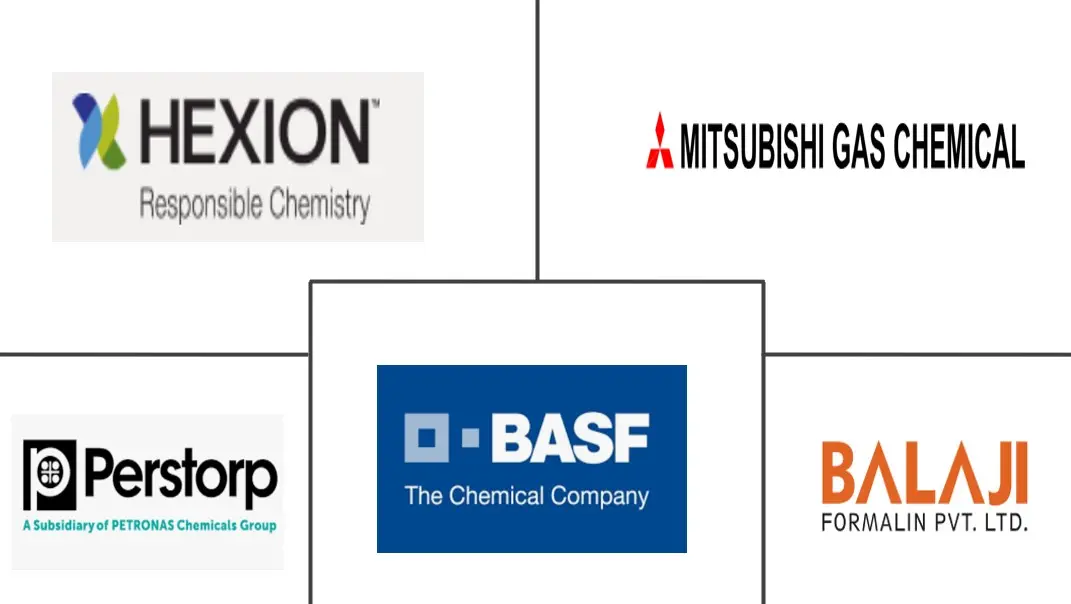Market Size of Asia-Pacific Formaldehyde Industry

| Study Period | 2019 - 2029 |
| Base Year For Estimation | 2023 |
| Market Volume (2024) | 16.02 Million tons |
| Market Volume (2029) | 19.68 Million tons |
| CAGR (2024 - 2029) | > 4.20 % |
| Market Concentration | Low |
Major Players
*Disclaimer: Major Players sorted in no particular order |
Asia-Pacific Formaldehyde Market Analysis
The Asia-Pacific Formaldehyde Market size is estimated at 16.02 kilotons in 2024, and is expected to reach 19.68 kilotons by 2029, growing at a CAGR of greater than 4.20% during the forecast period (2024-2029).
In 2020, the Asia-Pacific formaldehyde market faced setbacks due to the COVID-19 pandemic. Labor shortages led to temporary suspensions in key industries like construction and automotive, curtailing formaldehyde consumption. However, post-restrictions, the market rebounded robustly, driven by surging demand from the construction, automotive, and healthcare industries.
• Over the short term, growing demand from the construction industry and increasing usage in the automotive industry are expected to be the major factors driving the demand for the market studied.
• However, the toxic and carcinogenic nature of formaldehyde and stringent regulations amid growing environmental concerns are expected to hinder the market's growth.
• R&D on using formaldehyde for waste treatment is expected to create new opportunities for the market studied.
• China is expected to dominate the formaldehyde market in Asia-Pacific, and it is anticipated to witness the highest growth during the forecast period.
Asia-Pacific Formaldehyde Industry Segmentation
Formaldehyde, a colorless and highly reactive gas with a pungent odor, is produced through the catalytic oxidation of methanol. This flammable gas is a crucial precursor for various materials and chemical compounds. Its versatile and advantageous properties have led to its widespread use across numerous applications.
The Asia-Pacific formaldehyde market is segmented by derivative, end-user industry, and geography. By derivative, the market is segmented into urea formaldehyde, phenol formaldehyde, melamine formaldehyde, hexamine, polyoxymethylene, and other derivatives (methylene diphenyl diisocyanate and butanediol). By end-user industry, the market is segmented into automotive, construction, agriculture, healthcare, chemical and petrochemical, and other end-user industries (paints and textiles). The report also covers the market size and forecasts for the formaldehyde market in eight major countries across Asia-Pacific. For each segment, the market sizing and forecasts have been done on the basis of volume (kilo tons).
| Derivative | |
| Urea Formaldehyde | |
| Phenol Formaldehyde | |
| Melamine Formaldehyde | |
| Hexamine | |
| Polyoxymethylene | |
| Other Derivatives (Methylene Diphenyl Diisocyanate and Butanediol) |
| End-user Industry | |
| Automotive | |
| Construction | |
| Agriculture | |
| Healthcare | |
| Chemical and Petrochemical | |
| Other End-user Industries (Paints and Textiles) |
| Geography | |
| China | |
| India | |
| Japan | |
| South Korea | |
| Malaysia | |
| Thailand | |
| Indonesia | |
| Vietnam | |
| Rest of Asia-Pacific |
Asia-Pacific Formaldehyde Market Size Summary
The Asia-Pacific formaldehyde market is poised for significant growth, driven by its extensive application in the construction and automotive industries. Despite the initial setbacks caused by the COVID-19 pandemic, which temporarily halted activities in major sectors like construction and automotive due to labor shortages, the market has rebounded. The pharmaceutical sector's sustained demand for formaldehyde, particularly for disinfectants and personal care products, helped mitigate the pandemic's impact. The market's expansion is further supported by the favorable chemical properties of formaldehyde, which make it a preferred choice in various applications. However, the market faces challenges due to formaldehyde's toxic and carcinogenic nature, which could hinder its growth trajectory. China is expected to maintain its dominance in the region, benefiting from robust construction activities and a growing automotive sector.
The demand for formaldehyde in the Asia-Pacific region is bolstered by its critical role in manufacturing pressed-wood products and its use as an adhesive in construction and automotive applications. The region's construction industry, particularly in China, India, and Japan, is a significant driver of formaldehyde demand, with substantial investments in infrastructure and housing projects. Additionally, the automotive sector's growth, especially in China, with its increasing production and sales of vehicles, including battery electric vehicles, further fuels the market. The fragmented nature of the market sees major players like BASF SE, Hexion, and Sabic actively participating, with companies like Balaji Formalin Private Limited expanding their production capacities to meet the rising demand. These trends indicate a positive outlook for the formaldehyde market in the Asia-Pacific region over the forecast period.
Asia-Pacific Formaldehyde Market Size - Table of Contents
-
1. MARKET DYNAMICS
-
1.1 Market Drivers
-
1.1.1 Growing Demand from the Construction Industry
-
1.1.2 Increasing Usage in the Automotive Industry
-
1.1.3 Other Drivers
-
-
1.2 Market Restraints
-
1.2.1 Toxic and Carcinogenic Nature of Formaldehyde
-
1.2.2 Stringent Regulations Amid Growing Environmental Concerns
-
1.2.3 Other Restraints
-
-
1.3 Industry Value-chain Analysis
-
1.4 Porter's Five Forces Analysis
-
1.4.1 Bargaining Power of Suppliers
-
1.4.2 Bargaining Power of Buyers
-
1.4.3 Threat of New Entrants
-
1.4.4 Threat of Substitute Products and Services
-
1.4.5 Degree of Competition
-
-
-
2. MARKET SEGMENTATION (Market Size by Volume)
-
2.1 Derivative
-
2.1.1 Urea Formaldehyde
-
2.1.2 Phenol Formaldehyde
-
2.1.3 Melamine Formaldehyde
-
2.1.4 Hexamine
-
2.1.5 Polyoxymethylene
-
2.1.6 Other Derivatives (Methylene Diphenyl Diisocyanate and Butanediol)
-
-
2.2 End-user Industry
-
2.2.1 Automotive
-
2.2.2 Construction
-
2.2.3 Agriculture
-
2.2.4 Healthcare
-
2.2.5 Chemical and Petrochemical
-
2.2.6 Other End-user Industries (Paints and Textiles)
-
-
2.3 Geography
-
2.3.1 China
-
2.3.2 India
-
2.3.3 Japan
-
2.3.4 South Korea
-
2.3.5 Malaysia
-
2.3.6 Thailand
-
2.3.7 Indonesia
-
2.3.8 Vietnam
-
2.3.9 Rest of Asia-Pacific
-
-
Asia-Pacific Formaldehyde Market Size FAQs
How big is the Asia-Pacific Formaldehyde Market?
The Asia-Pacific Formaldehyde Market size is expected to reach 16.02 million tons in 2024 and grow at a CAGR of greater than 4.20% to reach 19.68 million tons by 2029.
What is the current Asia-Pacific Formaldehyde Market size?
In 2024, the Asia-Pacific Formaldehyde Market size is expected to reach 16.02 million tons.

